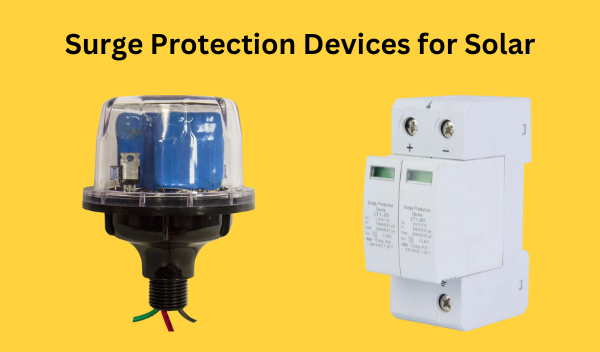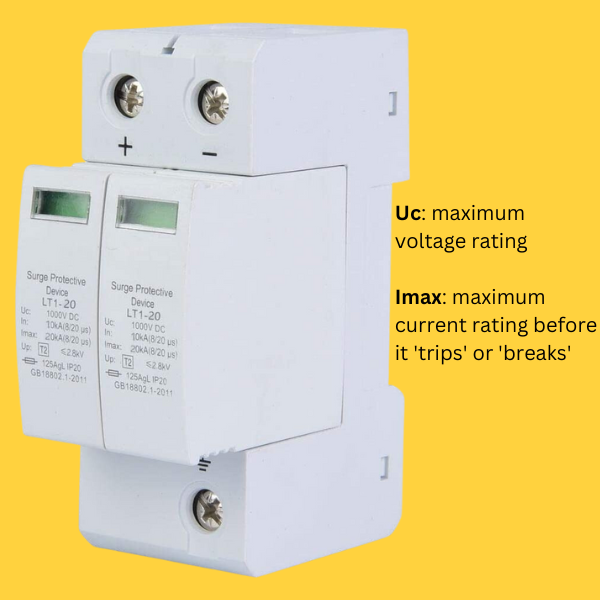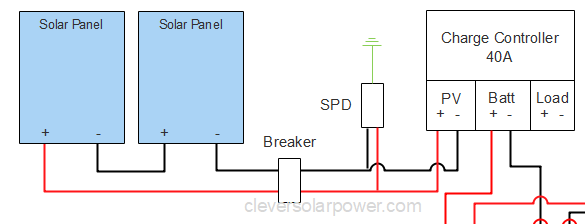Protecting your solar power system is crucial, and a Direct Current (DC) Surge Protection Device (SPD) can play a key role.
In this guide, we’ll explore the importance of a DC SPD, discuss its role in a solar system, and provide practical advice on sizing, selecting, and wiring an SPD. Whether you’re an experienced solar system owner or a beginner, this article will help you understand how to safeguard your investment effectively.

What is a DC SPD for a Solar system?
A DC surge protection device (SPD) protects your system from overvoltage due to lightning strikes or unusual high voltage spikes from the grid. In this article, I will talk about installing a surge protection device for solar panels.
How to size a Surge protection device for a solar system
You size the surge protection device according to the voltage of your solar array, whether its wired in series or parallel.
Let’s say the combined voltage of your solar array is 500VDC; then, you need to get an SPD rated at 500VDC. There are many 1000VDC surge protection devices for sale, but this one would be oversized for your application. Stay as close as possible to the maximum input voltage of your MPPT charge controller.

There are two types of SPD: one for households, which works on AC, and one for solar, which we are discussing here. Ensure you get the DC version for your solar input.
Here’s a general guide on how to size an SPD for a solar system:
- Determine the Maximum Operating Voltage: The SPD should be rated for the maximum operating voltage of your solar system. This is typically the maximum voltage of your solar panels for a DC system. For an AC system, this is the voltage of your grid connection. This is displayed as Uc on the device. A lighting strike will be much higher than the Voc of your solar array, so you can still choose an SPD with 1000VDC or 2000VDC if you only seek to protect against lightning strikes.
- Choose the Type of SPD: There are two types of SPDs: Type 1 and Type 2. For a solar system, you’ll typically need a Type 2 SPD unless your installation is at high risk of direct lightning strikes, in which case a Type 1 SPD may be necessary.
- Consider the Location of the Installation: The location of your solar system can affect the size of the SPD you need. For example, if your system is installed in an area with a high lightning density, you may need an SPD with a higher discharge capacity.
- Check the SPD’s Energy Rating: The SPD should have a sufficient energy rating to handle the maximum surge energy in your system. The manufacturer typically specifies this.
How to wire a surge protection device for solar panels

Wiring an SPD is relatively easy. After your solar disconnect, take the positive and negative and bring it to the input of the SPD device. The output of the SPD device needs to be connected to the ground. It is connected to the ground to dissipate the excess power.
If you already have a ground rod or loop, do not place a dedicated grounding rod for the SPD, as you will create a ground loop. Add the ground to your existing grounding rod or loop.
FAQ
Do solar isolators need to be double or single pole?
I have written an article about it: Do solar isolators need to be single or double pole?
Do solar panels need surge protection?
It is not required, but it is an extra safety measure to protect the DC input of your charge controller.
What is the difference between type 1 and type 2 surge protection devices?
Type 1 SPDs are designed to protect electrical installations from direct lightning strikes. They are installed in the main distribution board and are characterized by their ability to discharge the lightning current. Type 1 SPDs are typically used when the building has an external Lightning Protection System (LPS).
Type 2 SPDs are designed to protect against indirect lightning strikes and power surges usually caused by switching operations, motors starting up, or the operation of heavy machinery. They are installed downstream from Type 1 SPDs and are typically used to protect important industrial or commercial building equipment.
The main difference between Type 1 and Type 2 SPDs is the type of surge they are designed to protect against. Type 1 SPDs are designed to handle the high energy surges from a direct lightning strike, while Type 2 SPDs are designed to handle lower energy surges typically caused by indirect lightning strikes or electrical equipment operations.
Do I need to replace my surge protection device after an overvoltage?
if the overvoltage or surge is significantly larger than what the SPD is rated to handle, the SPD can fail or “break.” This is typically designed to happen safely, with the SPD disconnecting itself from the circuit to prevent a fire or other safety hazard. Some SPDs have indicators to show when they have failed and need to be replaced.
It’s important to note that while an SPD can protect against overvoltages, it cannot protect against sustained overvoltages or overcurrents, such as those that might occur due to a fault in the power supply or a short circuit. Other protective devices, such as circuit breakers or fuses, are needed to protect against these events.
Recommended SPD devices for solar
Midnite solar 300VDC surge protector: check price
1000VDC surge protector for DIN rail: check price
[custom-related-posts title=”Related Posts” none_text=”None found” order_by=”title” order=”ASC”]
I’m an off-grid enthusiast. I created this website to give clear and straight-to-the-point advice about solar power. I’m also the author of the book ‘Off-grid solar power simplified‘. Read more about me on my about page, check out my Youtube channel, or send me a message.
Dear Nick Seghers, useful and informative article.Hope to cooperate with you.We are manufacturer of SPDs with 30 years of experience: repsun.com.cn
Best regards,
Jason
Hello Jason, please contact me on my email for cooperation.
I appreciate your inforamation on SPD
ok